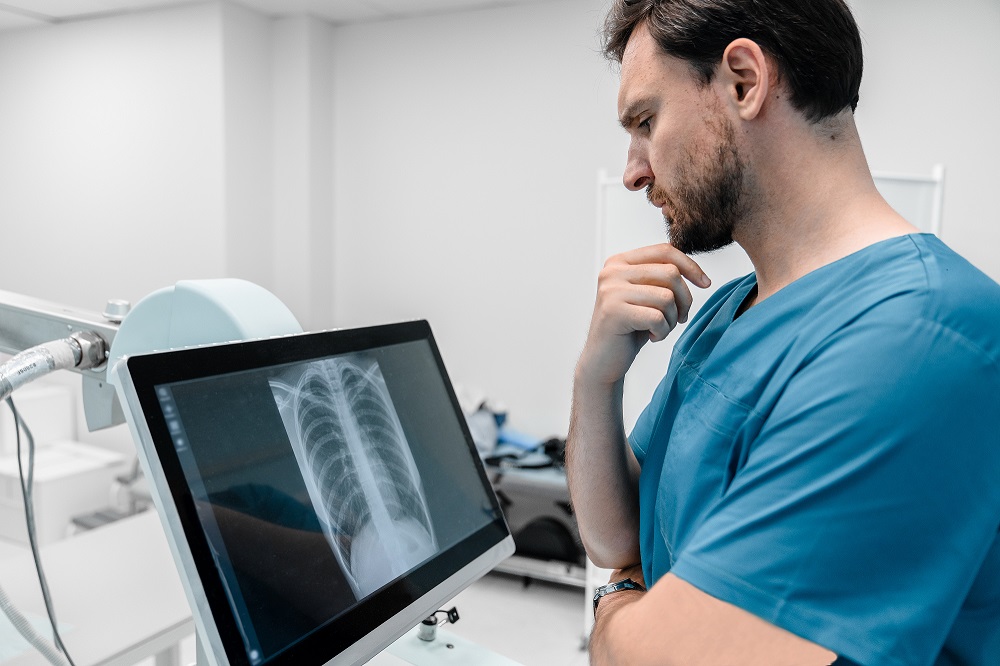Purpose and Indications
The primary purpose of performing an X-ray of the Lumbo-Sacral spine is to visualize the bones of the lower back and assess their alignment, integrity, and any pathological changes. Some of the key indications for this imaging procedure include:
1] Back Pain Evaluation: One of the most common reasons for performing a Lumbo-Sacral X-ray is to investigate chronic or acute lower back pain. X-rays help in identifying structural abnormalities such as fractures, disc degeneration, or spinal misalignments that may contribute to pain.
2] Fractures: An X-ray can detect fractures in the vertebrae, sacrum, or coccyx resulting from trauma, falls, or accidents. This is crucial in assessing whether a spinal fracture is compressing or affecting the nerves.
3] Degenerative Diseases: Conditions such as osteoarthritis, spondylosis, or degenerative disc disease often show up on an X-ray as narrowing of the intervertebral discs, bone spurs, and changes in bone density.
4] Spinal Deformities: X-rays are useful in identifying scoliosis (side-to-side curvature), kyphosis (forward curvature), or lordosis (excessive inward curvature), which can affect posture and lead to pain or mobility issues.
5] Infections and Tumors: Bone infections (osteomyelitis) or tumors (benign or malignant) can cause changes in the bone structure that are detectable on an X-ray.
6] Post-surgical Follow-up: After surgeries such as spinal fusion or disc replacement, X-rays are used to monitor the success of the procedure and ensure proper alignment of the spine.
If you're searching for an X-Ray (Lumbo-Sacral) in Pune, Diagnopein is the best digital X-ray centre near me, offering precise and reliable imaging services. This X-ray focuses on the lumbar spine and sacral region, crucial for diagnosing conditions such as lower back pain, sciatica, disc degeneration, or spinal injuries. Utilizing advanced digital technology, we ensure accurate results with minimal radiation exposure. Our expert radiologists provide detailed assessments, aiding your doctor in determining the right treatment plan. Experience quick, patient-friendly service in a modern facility. Choose Diagnopein for top-notch diagnostics and exceptional care in Pune.
Technique and Procedure
The Lumbo-Sacral X-ray is typically performed in a radiology department or clinic. The process is non-invasive and relatively quick, usually taking only a few minutes to complete. Here's how the procedure generally works:
1] Patient Positioning: The patient is asked to lie flat on an X-ray table, and in some cases, to stand. To get a clear view of the lower spine, several different angles or views are taken. Common views include:
2] Anteroposterior (AP) view: The patient is positioned lying on their back, and the X-ray beam is directed from front to back to capture the full view of the lumbar spine and sacrum.
3] Lateral view: The patient lies on their side, and the X-ray is directed from the side to capture the lateral aspect of the lumbar spine and sacrum.
4] Oblique view: Sometimes, an oblique angle is used to assess the alignment of the vertebrae more clearly.
5] X-ray Equipment: The radiologic technologist operates the X-ray machine, adjusting the settings for the patient’s size, age, and clinical history. A lead apron may be provided to shield other parts of the body from radiation.
6] Imaging: During the X-ray, the patient is asked to remain still to ensure clear and accurate images. In some cases, the patient may be asked to hold their breath briefly while the X-ray is taken.
7] Exposure: The X-ray machine uses a controlled amount of ionizing radiation to capture the images. The amount of radiation used is low, and the procedure is generally safe, with minimal risks when performed appropriately.
8] Image Interpretation: Once the images are captured, the radiologist reviews them for any abnormalities in bone density, alignment, or signs of degenerative changes. The images are then provided to the referring doctor to help in making a diagnosis.
Advantages and Limitations
1] Quick and Non-invasive: The X-ray procedure is relatively fast, taking only a few minutes to complete, with no need for invasive procedures or preparation.
2] Effective for Bone Evaluation: X-rays are excellent for visualizing bone structures, making them ideal for diagnosing fractures, bone deformities, and degenerative conditions.
3] Widely Available: X-ray equipment is common and accessible, making this test a first-line imaging option in many medical facilities.









